In Australia, like in many other countries, the type of workplace injuries can vary across industries and job types.
In 2023, the Australian Bureau of Statistics released a report capturing the 2021–22 statistics on work-related injuries in Australia. Of the 14.1 million people who had worked at some time during the 12 month period, there were 497,300 people who experienced a work-related injury or illness. This represents a 3.5% work-related injury rate, which is down from 4.2% in 2017-18 and 6.4% in 2005-06.
However, the most common causes of workplace injuries and illnesses in Australia are the same as they were 5 years ago:
- sprains, strains or dislocations 29%
- chronic joint or muscle conditions 20%
- cuts or open wounds 13%
- fractures
- stress or other mental condition
- crushing injury/internal organ damage
The top two injury types in this list make up almost 50% of all injuries in Australian workplaces.

Some of the most common workplace injuries reported in Australia include:
- Muscular stress while lifting or handling objects: This injury accounts for close to 40% of time off work and is the most regular workplace injury in Australia. Proper training and supervision can help prevent muscular stress injuries.
- Injuries to the arms, shoulders, and hands: Data collected from 2003-2016 in New South Wales shows that injuries to the arms, shoulders, and hands are the most common, with 13,317 claims received from January 2019 to July 2019. Manual handling is a significant cause of these injuries.
- Injuries to the legs, including hips and feet: These are also common workplace injuries, with 7,398 reported cases.
- Injuries to the back: Back injuries are also prevalent, with 5,920 reported cases.
- Falls in the workplace: Falls are a leading cause of death and serious injury in Australia, with falls on stairs being common and often leading to serious injuries.
- Repetitive strain injuries (RSIs): Jobs that involve repetitive motions, such as typing or assembly line work, can lead to RSIs like carpal tunnel syndrome or tendonitis. These are also a common cause for workplace hand injuries, according to SafeWork Australia.
- Other common causes of work-related injuries: These include lifting, pushing, pulling, bending, slip, trip, stumble (fall on the same level), hitting or being hit or cut by an object or vehicle, and stress or exposure to mental stress.
Most work-related injuries occurred in the workplace (91%), whilst 6% occurred when workers were travelling for work, travelling to or from work, or on a break. 1% of injuries occurred while workers were working from home.
Of the 497,300 people who experienced a work-related injury or illness during the 12 month period, two thirds (66%) had some time off work. Of those who took time off:
- 10% took part of a day/shift off
- 36% took 1-4 days off
- 17% took 5-10 days off
- 34% took +10 days off
- 4% had not returned to work since the injury or illness occurred
Of those who took time off work, the injuries or illnesses that had the highest average number of days off were:
- Stress or other mental health conditions – 44 days absent
- Fractures or broken bones – 29 days absent
- Chronic joint or muscle conditions – 22 days absent

Australians lost a total of 1.9 million weeks of work from work-related injury in the 12 months measured. So its essential to minimise the risks to reduce this lost work for all parties involved.
Both employees and employers have a role to play in reducing workplace incidents that can lead to time off and Workers’ Compensation claims. But here are some important ways that an employer could protect their employees:
- Training
- Supervision
- Tools, machinery and PPE (personal protective equipment)
- Adequate breaks
- Task variation
- Early intervention
- Reporting process
- Making improvements based on learnings
- Audits
So where does Workers’ Compensation start to play a role?
Of those who experienced a work-related injury in the 12 months, over half (57%) received some sort of financial assistance. Of those who received financial assistance:
- 54% received Workers’ Compensation.
- 43% did not apply for Workers’ Compensation.
- 3% applied for and did not receive Workers’ Compensation.
The number of people who did not receive financial assistance has decreased from 47% in 2017-18 to 43% in 2021-22.
The proportion of people who experienced a work-related injury and were on Workers’ Compensation has increased from 27% in 2017-18 to 31% in 2021-22.
Of the 323,700 people who did not apply for Workers’ Compensation:
- 39% did not apply because they considered their injury to be minor or did not think Workers’ Compensation was necessary.
- 14% did not think they were eligible for Workers’ Compensation.
- 10% were not covered or not aware of Workers’ Compensation.
“Workplace injuries can have a significant impact on both individuals and businesses, so it’s crucial to prioritise safety and injury prevention in the workplace, but also ensure individuals understand what is available to them and how they can explore their options when dealing with a workplace injury.”
If you need further information on workplace injuries and how to handle them, it’s advisable to contact relevant authorities or legal consultants for guidance. We have summarised the process for Workers’ Compensation in Australia, head to our article to find out more.
Sources:

